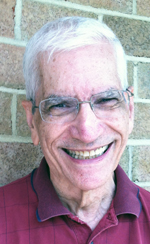By Joel H. Cohen

NEW YORK — As an American-born kid trying to absorb the full horror and magnitude of the Holocaust, I’d sit in a crowded baseball stadium and imagine the thousands of us being rounded up and marched to a concentration camp.
Then, obsessively, I’d try to calculate how many spectator-packed stadiums it would take to total six million.
Over time, I’d meet several Holocaust survivors, who had hidden, been hidden or otherwise managed to live through the atrocities.
One man had survived the Shoah in Hungary with the help of false papers – and a Nazi ring – bought at a flea market. False papers also protected members of his family and, when circumstances were becoming even more dire, a non-Jewish family friend took the man’s niece to his relatives, telling them the girl was his illegitimate child. The youngster was cared for, and survived.
With apartments scarce, my friend shared one with a stranger, who proudly showed a photo of a woman he said was his sister, with her children, under a Christmas tree. In later years, my friend and his apartment-mate, who’d both been living a lie posing as non-Jews – met in a shul in Manhattan.
Another longtime friend of ours was a passenger, with his younger sister and their mother, on the St. Louis, the ill-fated ship turned away from Cuba and the United States and returned to Germany, where many of the passengers, all Jews, became Holocaust fatalities.
In Havana Harbor, our friend, his sister and mother could see his father, who had preceded them, but not join him. Happily, the family survived the return to Germany and eventually were reunited, made it to the U.S. and were able to enjoy a career and life in Staten Island, New York.
So there were now faces illuminating the enormous numbers of Holocaust victims. Yet, as meaningful as these accounts were for grasping the Shoah’s horror, the greatest impact came with the discovery of someone I’d never meet.
In the Anne Frank House my wife and I visited in Amsterdam, Anne’s photos of Hollywood movie stars on her bedroom wall reminded me of the photos of baseball stars I used to hang on my wall. No big-deal coincidence. But the ordinariness of the movie photos emphasized how much like the rest of us as teenagers was this gifted, martyred child.
And then came the staggering fact: Anne and I were born just 18 day apart!
I don’t know whether it ‘s “guilt of survivorship” that makes my relationship with someone I’ve never met so strong. Is it because Anne was in many ways like the rest of us, or our children, and thus easy to identify with and mourn? Is it because we’ve come to know her as a person, not a number and, while she symbolizes 6 million, the unique child who needlessly perished was someone real?
And, that, but for the grace of geography, our fates might have been reversed? Had we both lived here instead of there, we might have been neighbors, friends, classmates.
When, on June 12, 1942, Anne became 13, she was given a diary as a birthday present. One early entry:
“After May 1940, good times rapidly fled; first the war, then the capitulation, followed by the arrival of the Germans, which is when the suffering of us Jews really began.”
Numerous anti-Jewish decrees followed — having to wear an identifying star, surrendering their bicycles, being banned from trains, non-Jewish stores, cinemas, visiting Christian friends, and even sitting in their gardens after curfew time.
“But life went on, in spite of it all,” she wrote
In the U.S. a different kind of life went on, where I took my father and uncle to the baseball All-Star game with Bar Mitzvah gift money. Two nights later in Europe, the Frank family went into hiding. On July 8, Anne noted: “Jews in hiding who were found out or betrayed were sent to a concentration camp immediately, and the penalty for helping people was death.\
And then: “I can’t tell you how oppressive it is never to be able to go outdoors, I am afraid we shall be discovered and be shot…not exactly a pleasant prospect.”
On Staten Island, meanwhile, we bade sad but proud goodbyes to neighborhood teen-agers off to war, several of them to die in action.
At home, our fathers, too old for active military service, served as Air Raid wardens, and we youngsters reminded the wardens of the weekly meetings. Among those we summoned was a pleasant-seeming German man who occupied an attic apartment on our hilly street.
While Anne daydreamed about Hollywood and freedom, we went to the movies. There one day, Movietone News reported that the FBI had arrested several men as Nazi spies, one our kindly neighbor..
On June 6, 1944, the hope D-Day generated is reflected in Anne’s diary entry: “Great commotion in the Secret Annex. Would the long-awaited liberation that has been talked of so much, but which still seems too wonderful, too much like a fairy tale, ever come true?
It didn’t for Anne. Two months later, on Aug. 4, 1944, a truck pulled up outside the house and police headed directly for the bookcase on the third floor that concealed the Annex.
Anne and the others were loaded on cattle cars for a three-day journey to Auschwitz, the Nazi death camp. Anne and her sister Margot were sent to Bergen-Belsen, where they died of typhus in March 1945.
At the time of her death, Anne was 15. So she never had a Sweet Sixteen party . . . or a prom, or…
Still trying to grasp the enormity of the Holocaust, I mourn all the victims, but most of all my contemporary Anne Frank, so much like us and yet so very special.
*
Joel Cohen is a freelance writer based in New York. He may be contacted via joel.cohen@sdjewishworld.com